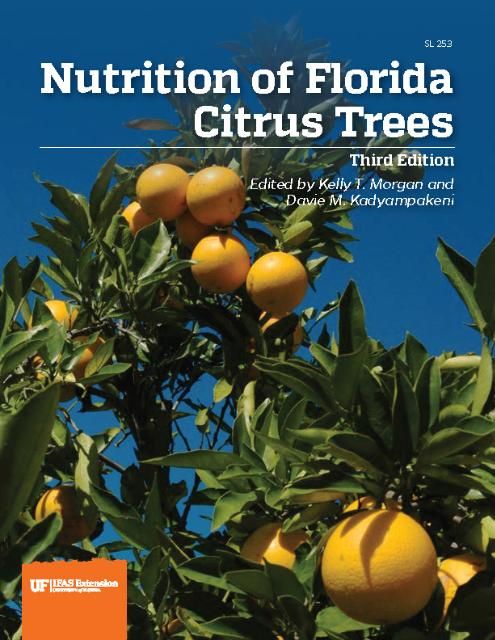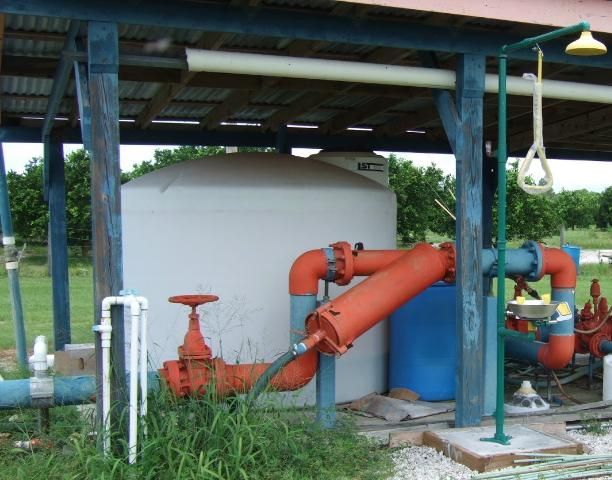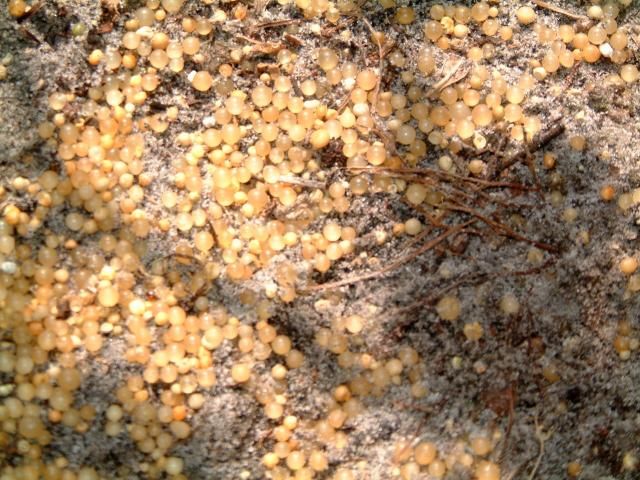
This document is SL460, one of a series of the Department of Soil, Water, and Ecosystem Sciences, UF/IFAS Extension. Original publication date February 2020. Visit the EDIS website at https://edis.ifas.ufl.edu for the currently supported version of this publication.
This publication is part of SL253, Nutrition of Florida Citrus Trees, 3rd Edition. For references, a glossary, and appendices, please refer to the full document at https://edis.ifas.ufl.edu/ss478.
Information in the box below applies to citrus trees affected by HLB. Other information in this chapter is valid for healthy citrus trees and trees with HLB.
Recommendations for HLB-affected trees:
Controlled-Release and Liquid Fertilizers—Davie Kadyampakeni, Mongi Zekri, Kelly Morgan, and Tripti Vashisth
Citrus tree growth, fruit quality, yield, and tree health are closely affected by plant nutrition. There are many fertilizer sources and formulations available for commercial citrus production. There are also different methods of applying fertilizers. Applying the right fertilizer type at the right rate at the right time and at the right location within the root zone is very important to improve nutrient use efficiency, especially for HLB-affected trees. For managing HLB-affected trees, constant supply of nutrients throughout the growing season is critical.
Controlled-release fertilizers (CRFs) contain one or more plant nutrients in a form that either delays their availability for plant uptake after application or extends their availability significantly longer than rapidly available fertilizers like ammonium nitrate, urea, or potassium chloride. CRFs were initially developed for their horticultural benefits, but they have also attracted attention in the best management practice (BMP) and HLB eras. CRFs have the advantages of inducing more growth and yield due to a continuous rather than a fluctuating supply of nutrients, reducing rates and frequency of fertilizer application, minimizing potential negative environmental effects, and bringing about substantial labor, time, and energy savings.
Liquid fertilizers applied weekly, biweekly, or monthly appear to improve the performance of HLB-affected trees. Repeated application of small amounts of nutrients improves canopy size, trunk growth, root development, and fruit yield by synchronizing nutrient applications with tree seasonal nutrient demand.
References
Kadyampakeni, D. M., K. T. Morgan, and A. W. Schumann. 2016. "Biomass, Nutrient Accumulation and Tree Size Relationships for Drip- and Microsprinkler-Irrigated Orange Trees." Journal of Plant Nutrition 39: 589–599.
Kadyampakeni, D. M., K. T. Morgan, A. W. Schumann, P. Nkedi-Kizza, and K. Mahmoud. 2014. "Phosphorus and Potassium Distribution and Adsorption on Two Florida Sandy Soils." Soil Science Society of America Journal 78: 325–334.
Kadyampakeni, D. M., K. T. Morgan, A. W. Schumann, P. Nkedi-Kizza, and K. Mahmoud. 2014. "Ammonium and Nitrate Distribution in the Soil Using Drip and Microsprinkler Irrigation for Citrus Production." Soil Science Society of America Journal 78: 645–654.
Introduction
Nitrogen fertilizers are classified as inorganic (e.g., ammonium nitrate), synthetic organic (e.g., urea), or natural organic (e.g., animal manure). Inorganic and synthetic organic N fertilizers are high-analysis materials that are most economical to use in citrus groves. They are rapidly available to plants unless coated as a component of controlled-release fertilizer. Natural organic materials are more slowly available and lower in analysis, so higher application rates are needed to supply equal amounts of available N compared with high-analysis fertilizer. For this reason, they are usually more expensive per unit of N.
Nutrients other than N are usually applied as inorganic fertilizers. An exception is when a grower applies a natural organic material like animal manure that contains a wide range of nutrients. Major P and K fertilizers are manufactured from mined products. Calcium, Mg, and S fertilizers are derived from mined sources like limestone and gypsum.
Micronutrients are usually applied as inorganic or synthetic organic fertilizers. Common micronutrient fertilizers and their analyses are listed in Appendix B. Salt index values for typical fertilizer sources and examples of how to calculate the salt index of a fertilizer blend are shown in Appendix C.
Solid Sources for Soil Application
Solid sources are typically bulk-blended into N-K2O or complete N-P2O5-K2O fertilizers, often including micronutrients, for spreading in citrus groves. Uniform particle size is required to prevent bulk blends from separating during transport to the grove or transfer from delivery trailer to spreader (Figure 1).

Credit: Stephen Futch, UF/IFAS
Most solid nutrient sources are readily water-soluble and rapidly available for tree uptake (Appendix D, Table 33). Solid fertilizers are applied with conventional spreading equipment but are sometimes applied by hand to young trees. Common solid sources applied to citrus grove soils include:
Nitrogen
- Ammonium nitrate
- Ammonium sulfate
- Urea
- Calcium nitrate
- Potassium nitrate
- Diammonium phosphate
Phosphorus
- Ordinary superphosphate
- Concentrated superphosphate
- Diammonium phosphate
Potassium
- Potassium chloride
- Potassium sulfate
- Potassium-magnesium sulfate
- Potassium nitrate
Calcium
- Calcium carbonate (calcitic lime)
- Calcium sulfate (gypsum)
- Calcium nitrate
Magnesium
- Magnesium carbonate (dolomitic lime)
- Potassium-magnesium sulfate
- Magnesium sulfate
- Magnesium oxide
Sulfur
- Ammonium sulfate
- Potassium sulfate
- Potassium-magnesium sulfate
- Ordinary superphosphate
- Calcium sulfate (gypsum)
- Elemental sulfur
Iron
- Iron oxy-sulfate
- Iron EDTA and HEDTA
- Iron DTPA
- Iron EDDHA
- Iron sucrate
- Iron humate
Manganese
- Manganese sulfate
- Manganese oxy-sulfate
- Manganese oxide
- Manganese nitrate
Zinc
- Zinc sulfate
- Zinc oxide
- Zinc nitrate
- Zinc EDTA and HEDTA
Copper
- Copper sulfate
Boron
- Borax (Sodium tetraborate)
Molybdenum
- Ammonium molybdate
- Sodium molybdate
Solid N Fertilizer Sources and Ammonia Volatilization
Loss of N fertilizer through ammonia volatilization is a concern in citrus groves because solid N sources applied to the soil surface are rarely incorporated. Up to 50% of the N in solid urea or ammonium-containing fertilizer sources can volatilize to the atmosphere when applied to citrus under two circumstances: 1) surface-applied ammonium fertilizer sources on calcareous or freshly limed soils; and 2) surface-applied urea on acid or alkaline soils.
Ammonia is easily lost from urea because it rapidly converts to ammonium carbonate following surface application. If not incorporated or watered in, ammonium carbonate readily decomposes to produce ammonia and carbon dioxide gases. An ammonium carbonate solution has a pH of about 8.6, which causes large ammonia losses whenever the gas is free to escape to the atmosphere as with surface application. Thus, urea volatilizes readily because it creates its own alkaline environment around each granule. If solid urea is dissolved and moved into the soil by irrigation or rainfall immediately after application, volatilization becomes insignificant.
When ammonium-containing fertilizers are surface-applied to soils containing free calcium carbonate (e.g., calcareous or freshly limed soils), an alkaline environment is maintained that allows conversion of ammonium ions to ammonia gas. The degree to which this reaction proceeds depends on the anion associated with the ammonium fertilizer. Those N fertilizers that react to form Ca-reaction products of low solubility will lose considerably more ammonia than fertilizers producing reaction products of relatively higher solubility. For example, ammonium sulfate will produce low-solubility gypsum (CaSO4) in combination with soil calcium, while ammonium nitrate will produce highly soluble calcium nitrate. Thus, if ammonium sulfate and ammonium nitrate are surface-applied to calcareous soil and are not immediately irrigated into the soil, more ammonium will volatilize from ammonium sulfate. It should be noted that N fertilizer in the nitrate form is not subject to volatilization.
Solution Sources—Fertigation
Fertigation is the application of solution fertilizer with irrigation water, typically through a microsprinkler or drip system (Figure 2; see chapter 7). The two most common nutrients applied to citrus through fertigation are N and K. Fertilizer injected into a microirrigation system should be a true solution with no solid contaminants. Solutions are made by dissolving readily soluble sources of plant nutrients in water.

Nutrient sources used to manufacture true solutions include:
Nitrogen
- Ammonium nitrate
- Urea
- Urea-sulfuric acid
- Ammonium sulfate
- Ammonium thiosulfate
- Calcium nitrate
- Potassium nitrate
Phosphorus
- Ammonium polyphosphate
- Phosphoric acid
Potassium
- Potassium chloride
- Potassium nitrate
- Potassium sulfate
- Potassium thiosulfate
Calcium
- Calcium nitrate
Magnesium
- Magnesium nitrate
- Magnesium sulfate
Micronutrients
- Borax
- Copper sulfate (acidified)
- Manganese sulfate (acidified)
- Manganese nitrate
- Zinc sulfate
- Zinc nitrate
- Zn, Mn, Cu, and Fe chelates (EDTA, DTPA, and/or EDDHA)
Growers should be cautious when applying solutions containing P through a microirrigation system. If the pH of the fertilizer-water mixture is not kept acidic, solution P can combine with dissolved Ca in the irrigation water to form an insoluble precipitate that will clog irrigation emitters. Some commonly used liquid formulations, their analyses, and weights per gallon are shown in Appendix D.
Solution Fertilizer Salt-Out
Solution fertilizer salt-out (crystallization) in storage tanks can be a problem during the winter. The most important factor affecting salt-out temperature of a fertilizer solution is the amount of N and K in it. The higher the analysis of a solution, the higher the crystallization temperature. For example, a 10-0-10 solution fertilizer made from ammonium nitrate and potassium chloride will salt-out at about 60°F, while 8-0-8 and 6-0-6 solutions made from the same sources will salt out at about 41°F and 27°F, respectively. Solutions made with potassium nitrate will salt-out a few degrees lower than solutions made with potassium chloride. The addition of micronutrients to the solution will result in a minimal change in salt-out temperature.
Solution fertilizer suppliers can provide salt-out temperatures for specific mixtures. If prolonged temperatures below the salt-out temperature are expected, crystallization should be prevented by diluting the solution with water. Adding enough water to lower the N and K grades to less than 5% will prevent salt-out most of the time. If there is no room in the storage tank for dilution, adding polyphosphate can lower the salt-out temperature several degrees. However, polyphosphates are most effective when used with lower analysis solutions.
Solution Sources—Foliar Sprays
Both foliar-applied urea and potassium phosphite have been shown to increase flowering, fruit yield, and total soluble solids yield of Valencia orange trees in Florida. Foliar N has also been used as a substitute for part of a soil-applied N fertilization program in an effort to decrease N leaching potential.
If urea is to be foliar-applied, only spray-grade, low-biuret (less than 0.25%) material should be used to avoid biuret toxicity. Tank-mixing with pesticides, crop oil, and other products should be approached with caution, because urea can be phytotoxic when applied at higher rates, particularly in combination with oil.
Nutrient sources applied in foliar sprays include:
Nitrogen
- Low-biuret urea
Phosphorus
- Potassium phosphite
- Ammonium phosphite
- Phosphorous acid
Potassium
- Potassium nitrate
- Monopotassium phosphate
Micronutrients
- Manganese/zinc nitrates
- Manganese/zinc sulfates
- Copper sulfate
- Synthetic and natural organic chelates (many forms)
- Borax
Suspension Sources
Suspensions are fluid fertilizers in which solids are prevented from settling by a suspension agent, usually a swelling-type clay like attapulgite or bentonite. Suspensions are higher in concentration than true solution fertilizers because they contain both dissolved and nondissolved fertilizer. They can be uniformly applied to the soil surface as part of fertilizer-herbicide mixtures that sometimes include micronutrients. Mechanical agitation may be necessary to maintain fertilizer concentration uniformity in the tank. Suspensions are made from the same fertilizers sources used to make true solutions (see previous section on fertigation).
Slow-Release Sources
Slow-release sources are materials of limited water solubility that release plant-available nutrients as they decompose or degrade in the soil following application. Except for a few slow-release K sources, almost all slow-release fertilizers are N sources. The release process is either biological or chemical, and slow-release fertilizers are grouped accordingly. For example, release of N from urea formaldehyde requires both dissolution of the fertilizer and microbial decomposition, while release of N from isobutylidene diurea (IBDU) involves slow dissolution only. Processed waste products release N through microbial degradation. Examples include biosolids, composts, and tankages.
Slow-release nutrient sources applied to Florida citrus include:
- Sulfur-coated urea
- Urea formaldehyde
- Ureaform
- Methylene urea
- IBDU
- Organiform (tankage)
- Animal manures
- Municipal biosolids
- Municipal composts
Controlled-Release Sources
Controlled-release fertilizers (CRFs) contain one or more plant nutrients in a form that either delays their availability for plant uptake after application or extends their availability significantly longer than rapidly available fertilizers like ammonium nitrate, urea, or potassium chloride. CRFs were initially developed for their horticultural benefits, but they have also attracted attention in the BMP and citrus greening era. CRFs have the advantages in inducing more growth and yield due to a continuous rather than a fluctuating supply of nutrients, reducing rates and frequency of fertilizer application, minimizing potential negative environmental effects, and bringing about substantial labor, time, and energy savings.
Controlling the release of nutrients is accomplished by surrounding conventional water-soluble fertilizer sources with a coating (Figure 3). Substances successfully used as coatings either alone or in combination include polymers, plastics, waxes, and sulfur. The standard (reference) release rate of a particular material is controlled by varying the coating thickness or physical characteristics during manufacture, but nutrient release is also typically influenced by soil temperature, water content, and microbes.

Controlled-release fertilizers are substantially more expensive than conventional sources, so their use may be limited to special situations such as young tree fertilization or nutrient management in environmentally sensitive areas. Many diverse CRF products have been developed, and the technology continues to advance. Most CRFs contain a complete N-P-K fertilizer combination with small amounts of micronutrients. Growers are advised to consult the label of such products to determine release characteristics and recommended application rate.
Citrus fertilization research conducted in Florida within the past 30 years showed that tree growth and fruit yield where part or all of the fertilization program included CRFs were similar or greater than growth and yield resulting from an all-conventional water-soluble N fertilization program. CRFs are more efficient, have low plant injury hazard, and have less leaching and volatilization potential than conventional soluble fertilizers.
Formulating Fertilizer Products
More than 80% of the fertilizer sold in Florida is bulk-blended at the request of the customer. It is possible to obtain almost any requested combination of nutrients through blending of the various base sources shown in Appendix B. In most fertilizer plants, blends are prepared by mixing the base sources and conveying the mixture to a bulk trailer or into bags. An example of the procedure used to formulate a fertilizer mixture is shown in Appendix E.
Nutrient Sources for Organic Citrus Production
Organic citrus production relies on plant and animal materials as nutrient sources and some mined raw minerals as opposed to inorganic chemical-based sources, so essentially all manufactured or synthetic fertilizers are prohibited. In particular, materials containing chloride, nitrate, and highly soluble phosphate cannot be used. Although biosolids (processed wastewater residuals) are organic materials, they are prohibited from organic farming due to concerns about metals content.
An example list of nutrient sources that can potentially be used for organic citrus production is given below. Some are allowed with no restrictions, while others are restricted to special cases. Organic growers should consult their certifying organization for specific rules and guidelines.
- Legumes
- Composted food and forestry by-products
- Wood ash
- Crop residues
- Green manures
- Peat moss
- Straw
- Seaweed
- Animal manures
- Beef
- Bird or bat guano
- Dairy
- Poultry
- Swine
- Meals
- Alfalfa
- Bone
- Blood
- Cottonseed
- Fish
- Feather
- Hoof and horn
- Leather
- Soybean
- Minerals and salts
- Agricultural limestone
- Basalt
- Borax
- Bordeaux mixtures
- Chilean sodium nitrate
- Colloidal phosphate
- Greensand (glauconite)
- Granite (ground)
- Gypsum (mined raw material only)
- Kiln dust
- Langbeinite (K-Mg sulfate—mined raw material only)
- Micronutrient-sulfate salts
- Natural rock phosphate
- Potassium sulfate (mined only)
- Sodium nitrate (mined only)—limited use
- Sodium molybdate
- Sulfur (mined only)
- Zinc sulfate
Chapter 11 (section on Organic Citrus Production) presents additional information about soil fertility and nutrient management guidelines for organic citrus production.